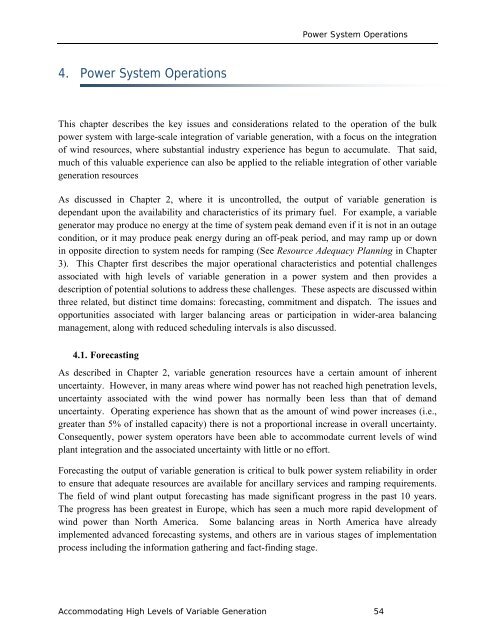Accommodating High Levels of Variable Generation - NERC
Accommodating High Levels of Variable Generation - NERC
Accommodating High Levels of Variable Generation - NERC
Create successful ePaper yourself
Turn your PDF publications into a flip-book with our unique Google optimized e-Paper software.
Power System Operations<br />
4. Power System Operations<br />
This chapter describes the key issues and considerations related to the operation <strong>of</strong> the bulk<br />
power system with large-scale integration <strong>of</strong> variable generation, with a focus on the integration<br />
<strong>of</strong> wind resources, where substantial industry experience has begun to accumulate. That said,<br />
much <strong>of</strong> this valuable experience can also be applied to the reliable integration <strong>of</strong> other variable<br />
generation resources<br />
As discussed in Chapter 2, where it is uncontrolled, the output <strong>of</strong> variable generation is<br />
dependant upon the availability and characteristics <strong>of</strong> its primary fuel. For example, a variable<br />
generator may produce no energy at the time <strong>of</strong> system peak demand even if it is not in an outage<br />
condition, or it may produce peak energy during an <strong>of</strong>f-peak period, and may ramp up or down<br />
in opposite direction to system needs for ramping (See Resource Adequacy Planning in Chapter<br />
3). This Chapter first describes the major operational characteristics and potential challenges<br />
associated with high levels <strong>of</strong> variable generation in a power system and then provides a<br />
description <strong>of</strong> potential solutions to address these challenges. These aspects are discussed within<br />
three related, but distinct time domains: forecasting, commitment and dispatch. The issues and<br />
opportunities associated with larger balancing areas or participation in wider-area balancing<br />
management, along with reduced scheduling intervals is also discussed.<br />
4.1. Forecasting<br />
As described in Chapter 2, variable generation resources have a certain amount <strong>of</strong> inherent<br />
uncertainty. However, in many areas where wind power has not reached high penetration levels,<br />
uncertainty associated with the wind power has normally been less than that <strong>of</strong> demand<br />
uncertainty. Operating experience has shown that as the amount <strong>of</strong> wind power increases (i.e.,<br />
greater than 5% <strong>of</strong> installed capacity) there is not a proportional increase in overall uncertainty.<br />
Consequently, power system operators have been able to accommodate current levels <strong>of</strong> wind<br />
plant integration and the associated uncertainty with little or no effort.<br />
Forecasting the output <strong>of</strong> variable generation is critical to bulk power system reliability in order<br />
to ensure that adequate resources are available for ancillary services and ramping requirements.<br />
The field <strong>of</strong> wind plant output forecasting has made significant progress in the past 10 years.<br />
The progress has been greatest in Europe, which has seen a much more rapid development <strong>of</strong><br />
wind power than North America. Some balancing areas in North America have already<br />
implemented advanced forecasting systems, and others are in various stages <strong>of</strong> implementation<br />
process including the information gathering and fact-finding stage.<br />
<strong>Accommodating</strong> <strong>High</strong> <strong>Levels</strong> <strong>of</strong> <strong>Variable</strong> <strong>Generation</strong> 54
















